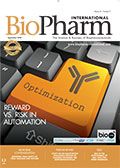USP Proposes a New Chapter for Rapid Sterility Testing
The US Pharmacopeial Convention (USP) is developing a new chapter for rapid sterility testing of short-life products based on the recommendations of a panel of experts and stakeholders.
The US Pharmacopeial Convention (USP) is developing a new chapter for rapid sterility testing of short-life products based on the recommendations of a panel of experts and stakeholders. The new general information chapter, <1071> Rapid Sterility Testing of Short-Life Products: A Risk-Based Approach, has been proposed in the September–October 2018 issue of Pharmacopeial Forum (PF), USP’s free-access, online journal, and is open for public comment until Nov. 30, 2018.
This general information chapter discusses the needs of stakeholders who prepare or manufacture short-life products, their user requirement specifications, and suitable sterility testing technologies based on these specifications. USP plans to follow this first chapter with a second chapter on test methods, covering technologies that can be advanced as compendial methods. USP standards are published in the United States Pharmacopeia and National Formulary (USP–NF).
While many contributing factors may affect the quality of a medicine or its ingredients, controlling microbial contamination is essential throughout the product’s life cycle. For both sterile and nonsterile pharmaceuticals, manufacturers must eliminate or minimize potential microbiological productbased risks to patients. Conventional microbiology tests found in the pharmacopeias and used to detect microbial contamination, such as sterility tests, rely on demonstrating microbial growth. However, these tests show limited sensitivity, and can be time- and laborintensive to use.
USP recognizes that great advances have been made recently in microbiological testing for the pharmaceutical and biotechnology industries. One key requirement for any test method is to detect a contaminated dose before it is administered to a patient, and current testing methods do not permit this. A case in point is growth-based sterility testing, which requires an incubation period of at least 14 days, rendering it useless for short-life products or those intended for immediate use. In addition, current specifications for the quantities of material to be tested are not suitable for short-lived products, which are made in batches of small sample sizes. Examples would include compounded sterile preparations, materials used in positron emission tomography, and cell and gene therapies, which require a new generation of risk-based rapid sterility tests.
Deficiencies in existing methods led USP to assemble the panel of technology experts and representative stakeholders from the sterile compounding, positron emission tomography (PET), cell therapy, pharmaceutical, and contract testing industries who collaborated on this chapter, to weigh in on the best methods. This panel helped USP establish user requirement specifications and recommended suitable technologies for the rapid sterility testing of short shelf-life products.
Based on the user requirements and available technologies, there are trade-offs among detection limits, sample size, and time to results. The best way to utilize these technologies is by developing a risk-based approach that offer detection limits and time best suited to each stakeholder group.
About the author
Radhakrishna S. Tirumalai, PhD, principal scientific liaison-General Chapters, Science and Standards Division, United States Pharmacopeial Convention
Article Details
BioPharm International
Vol. 31, Number 9
September 2018
Page: 42
Citation
When referring to this article, please cite as R.S. Tirumalai, “USP Proposes a New Chapter for Rapid Sterility Testing,” BioPharm International 31 (9) 2018.

Thermo Fisher Opens Advanced Therapies Collaboration Center in California
April 18th 2025The 6000-square-foot facility will provide cell therapy developers the support they need to transition to CGMP manufacturing, and an expanded footprint of the new center is expected to open in Philadelphia later in 2025.